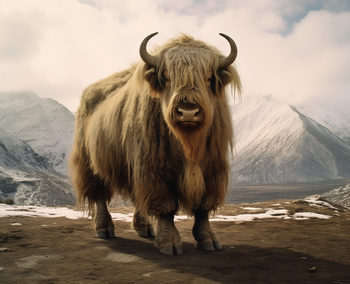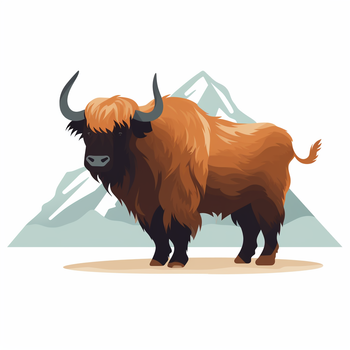Yak
|
|
| Revision as of 12:24, 29 Apr 2006 Academickids (Talk | contribs) ← Go to previous diff |
Current revision AcademicSysop2 (Talk | contribs) |
||
| Line 1: | Line 1: | ||
| - | {{Taxobox_begin | color = pink | name = Yak}} | + | {{Taxobox_begin | color = white | name = Yak}} |
| - | {{Taxobox_image | image = [[Image:Yak_Drawing_historic.jpg|240px|A drawing of a yak]] | caption = }} | + | {{Taxobox_begin_placement | color = white}} |
| - | {{Taxobox_begin_placement | color = pink}} | + | |
| {{Taxobox_regnum_entry | taxon = [[Animal]]ia}} | {{Taxobox_regnum_entry | taxon = [[Animal]]ia}} | ||
| {{Taxobox_phylum_entry | taxon = [[Chordate|Chordata]]}} | {{Taxobox_phylum_entry | taxon = [[Chordate|Chordata]]}} | ||
| Line 10: | Line 9: | ||
| {{Taxobox_species_entry | taxon = '''''gruniens'''''}} | {{Taxobox_species_entry | taxon = '''''gruniens'''''}} | ||
| {{Taxobox_end_placement}} | {{Taxobox_end_placement}} | ||
| - | {{Taxobox_section_binomial | color = pink | binomial_name = Bos gruniens | author = [[Carolus Linnaeus|Linnaeus]] | date = [[1766]]}} | ||
| {{Taxobox_end}} | {{Taxobox_end}} | ||
| - | The '''yak''' (''Bos grunniens'') is a long-haired humped domestic [[bovine]] found in [[Tibet]] and throughout the [[Himalaya]]n region of south [[central Asia]]. The word ''yak'' refers to the male of the species; a female is a ''dri'' or ''nak''. | + | Introduction |
| + | [[Image:Photo representing a wild yak in tibet.png|thumb|350px|left|Photo representing a wild yak in tibet [http://classroomclipart.com Classroom Clip Art]]] | ||
| + | '''Yaks''' (''Bos grunniens'') are robust, long-haired [[animal]]s predominantly found in the Himalayan region of South Asia, the Tibetan Plateau, and some parts of Central Asia. Known for their ability to thrive in harsh, high-altitude environments, yaks are integral to the lives of local communities. This article delves into the world of yaks, exploring their characteristics, lifestyle, and the crucial role they play in their ecosystems. | ||
| + | Physical Characteristics and Adaptations | ||
| + | Unique Anatomy | ||
| - | Wild yak (''Bos mutus'') stand about two meters tall at the shoulder. Domestic yak are about half that height. Both types have long shaggy hair to insulate them from the cold. Wild yak can be either brown or black. Domesticated ones can also be white. Yak milk is pink. | + | Yaks are characterized by their dense, woolly fur, which protects them from extreme cold. Adult yaks can weigh between 300 to 1,000 kilograms (660 to 2,200 pounds), with males being larger than females. They have sturdy, horned heads and a humped shoulder, adding to their imposing appearance. |
| + | Adaptations for High Altitude | ||
| + | |||
| + | Yaks have several adaptations that allow them to survive at altitudes above 15,000 feet. Their large lungs and heart efficiently use oxygen in the thin high-altitude air. Their stomachs are adapted to digest tough, fibrous plants found in their mountainous habitats. | ||
| + | Behavior and Lifestyle | ||
| + | Social Structure | ||
| + | |||
| + | Yaks are typically found in small herds, which provide protection against predators like wolves and snow leopards. These herds are often led by a dominant female. | ||
| + | [[Image:Yak near a mountain illustration.png|thumb|350px|right|Yak near a mountain illustration [http://classroomclipart.com Classroom Clip Art]]] | ||
| + | ==Diet and Grazing== | ||
| + | |||
| + | Yaks are herbivores, grazing on grasses, herbs, and other high-altitude vegetation. In winter, they use their strong hooves to break through snow to access grass. | ||
| + | Domestication and Human Use | ||
| + | ==Role in Local Economies== | ||
| + | |||
| + | Yaks have been domesticated for thousands of years by the people of the Himalayas and Tibetan Plateau. They are used as pack animals, carrying goods across mountain passes. Yak milk, butter, and cheese are staples in the local diet, and their wool is used for clothing and tents. | ||
| + | Cultural Significance | ||
| + | |||
| + | Yaks hold a place of reverence in many Himalayan cultures. They are often associated with local festivals and rituals and are respected for their endurance and strength. | ||
| + | ==Habitat and Distribution== | ||
| + | |||
| + | Yaks are native to the high-altitude regions of Central and South Asia. The majority of the wild yak population is found in the Tibetan Plateau, with smaller populations in India, Nepal, and Bhutan. | ||
| + | |||
| + | ==Conservation Status== | ||
| + | [[Image:Black white yak outline illustration.png|thumb|350px|right|black white yak outline illustration [http://classroomclipart.com Classroom Clip Art]]] | ||
| + | Wild yaks are classified as vulnerable. They face threats from habitat loss, competition with livestock, and climate change, which affects the fragile ecosystems of their high-altitude homes. | ||
| + | ==Conservation Efforts== | ||
| + | |||
| + | Efforts to protect yaks include habitat preservation, research on their ecological role, and community-based conservation programs that involve local populations in sustainable yak herding practices. | ||
| + | ==Interesting Facts== | ||
| + | |||
| + | *Yaks can survive at altitudes where most animals would suffer from hypoxia. | ||
| + | *They are excellent swimmers, despite their bulky size. | ||
| + | *Yak dung is a key fuel in treeless high-altitude areas. | ||
| + | *Yaks play a vital role in transporting goods along the ancient Silk Road. | ||
| Domesticated yak are kept primarily for their [[milk]] and [[meat]]; they are also used as beasts of burden, transporting goods across mountain passes for local farmers and traders as well as in support of climbing and trekking expeditions. Often the pack animals are actually crossbreeds of the yak and ''Bos taurus'' (common domestic [[cattle]]). These are known in Tibetan as ''[[dzo]]'' or ''dzopkyo''. | Domesticated yak are kept primarily for their [[milk]] and [[meat]]; they are also used as beasts of burden, transporting goods across mountain passes for local farmers and traders as well as in support of climbing and trekking expeditions. Often the pack animals are actually crossbreeds of the yak and ''Bos taurus'' (common domestic [[cattle]]). These are known in Tibetan as ''[[dzo]]'' or ''dzopkyo''. | ||
| Line 21: | Line 57: | ||
| It is a known fact that unlike the cows, the yak grunts rather than mooing. Owing to the fact that many of them are killed for food by the [[Tibetan people|Tibetans]], the wild yak has become an endangered species. | It is a known fact that unlike the cows, the yak grunts rather than mooing. Owing to the fact that many of them are killed for food by the [[Tibetan people|Tibetans]], the wild yak has become an endangered species. | ||
| - | The term "yak" is also loosely used to describe someone, preferably a male, who has a tendency to be unreasonably silly in specific circumstances. This term was originally derived from the behavior displayed by Weston High School student Jacob Rubens. | + | |
| + | |||
| {{AnimalClipart}} | {{AnimalClipart}} | ||
Current revision
| Yak | ||||||||||||||
|---|---|---|---|---|---|---|---|---|---|---|---|---|---|---|
| Scientific classification | ||||||||||||||
|
Introduction
Yaks (Bos grunniens) are robust, long-haired animals predominantly found in the Himalayan region of South Asia, the Tibetan Plateau, and some parts of Central Asia. Known for their ability to thrive in harsh, high-altitude environments, yaks are integral to the lives of local communities. This article delves into the world of yaks, exploring their characteristics, lifestyle, and the crucial role they play in their ecosystems. Physical Characteristics and Adaptations Unique Anatomy
Yaks are characterized by their dense, woolly fur, which protects them from extreme cold. Adult yaks can weigh between 300 to 1,000 kilograms (660 to 2,200 pounds), with males being larger than females. They have sturdy, horned heads and a humped shoulder, adding to their imposing appearance. Adaptations for High Altitude
Yaks have several adaptations that allow them to survive at altitudes above 15,000 feet. Their large lungs and heart efficiently use oxygen in the thin high-altitude air. Their stomachs are adapted to digest tough, fibrous plants found in their mountainous habitats. Behavior and Lifestyle Social Structure
Yaks are typically found in small herds, which provide protection against predators like wolves and snow leopards. These herds are often led by a dominant female.
| Contents |
Diet and Grazing
Yaks are herbivores, grazing on grasses, herbs, and other high-altitude vegetation. In winter, they use their strong hooves to break through snow to access grass. Domestication and Human Use
Role in Local Economies
Yaks have been domesticated for thousands of years by the people of the Himalayas and Tibetan Plateau. They are used as pack animals, carrying goods across mountain passes. Yak milk, butter, and cheese are staples in the local diet, and their wool is used for clothing and tents. Cultural Significance
Yaks hold a place of reverence in many Himalayan cultures. They are often associated with local festivals and rituals and are respected for their endurance and strength.
Habitat and Distribution
Yaks are native to the high-altitude regions of Central and South Asia. The majority of the wild yak population is found in the Tibetan Plateau, with smaller populations in India, Nepal, and Bhutan.
Conservation Status
Wild yaks are classified as vulnerable. They face threats from habitat loss, competition with livestock, and climate change, which affects the fragile ecosystems of their high-altitude homes.
Conservation Efforts
Efforts to protect yaks include habitat preservation, research on their ecological role, and community-based conservation programs that involve local populations in sustainable yak herding practices.
Interesting Facts
- Yaks can survive at altitudes where most animals would suffer from hypoxia.
- They are excellent swimmers, despite their bulky size.
- Yak dung is a key fuel in treeless high-altitude areas.
- Yaks play a vital role in transporting goods along the ancient Silk Road.
Domesticated yak are kept primarily for their milk and meat; they are also used as beasts of burden, transporting goods across mountain passes for local farmers and traders as well as in support of climbing and trekking expeditions. Often the pack animals are actually crossbreeds of the yak and Bos taurus (common domestic cattle). These are known in Tibetan as dzo or dzopkyo.
It is a known fact that unlike the cows, the yak grunts rather than mooing. Owing to the fact that many of them are killed for food by the Tibetans, the wild yak has become an endangered species.
Clipart and Animal Pictures
- Clipart (https://classroomclipart.com/image/category/clipart.htm)
- Animal Clipart (https://classroomclipart.com/image/category/animal-clipart.htm)
- Animal Animated Clipart (https://classroomclipart.com/clipart/Animations/Animals.htm)
- Pictures of Animals (https://classroomclipart.com/image/category/animal-photos.htm)
- Amphibian Clip Art, Pictures and Photogaphs (https://classroomclipart.com/image/category/amphibian-clipart.htm)
- Farm Animal Clip Art, Pictures and Photographs (https://classroomclipart.com/image/category/farm-animal-clipart.htm)
- Mammal Clip Art, Pictures and Photographs (https://classroomclipart.com/image/category/mammal-clipart.htm)
- Marine Animal Clip Art, Pictures and Photographs (https://classroomclipart.com/image/category/marine-life-clipart.htm)
- Reptile Clip Art, Pictures and Photographs (https://classroomclipart.com/image/category/reptile-clipart.htm)
- Spider Clip Art, Pictures and Photographs (https://classroomclipart.com/image/category/spider-clipart.htm)




